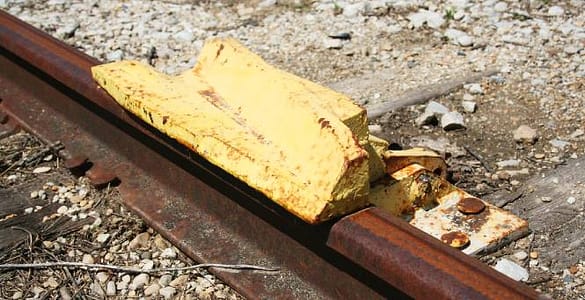

Any person who maliciously removes, displaces, injures, or destroys any part of a railroad, a steam or horse car, any track, branch, branch way, switch, turnout, bridge, viaduct, culvert, embankment, station house, structure, fixture, or any part attached or connected to; including placing an obstruction on any part of the railroad.
A railroad is any means of transporting passengers and their belongings in a mode of transportation on rails that are affixed on tracks. Rail vehicles stay on the rails affixed by tracks for guidance.
Urban railroads refer to transport in suburban and urban areas. Examples include tram, rapid transport, monorails, commuter rails, funiculars. Tram rail systems are used in locations like New Orleans or San Francisco and other public urban streets for above street level travel. They are designated for street car mobility and are accessible by pedestrians. Rapid rail systems are underground for high-capacity travel. The New York subway system is an example.
High speed rails are high speed transits operating at speeds above 106 mph: the Japanese Bullet Train is an example. Monorails, use on rail systems and are elevated above ground on a bridge system. Commuter rails are like rapid transport for high capacity but operate above ground and travel from urban to suburban areas. Funiculars are like gondolas but are elevated with cables to assist them transport passengers in forestry or mountainous areas.
A steam car is a car that uses a steam engine. That engine is a combustion engine consisting of a pilot light, boiling water and a burner that is typically fueled by kerosene. A horse car is a carriage towed or pulled by two or more horses. The premise is that steam cars and horse cars were conceptualized in the era of the rail cart and railroads and are still allowed to operate on tram railroad systems.
A branch is an off-route railroad station that connects to the main station. The branch ways are the rail systems that extend the branch station to other routes. A railroad switch is an installed pivot that allows railroad carts to transfer from one set of rails to another. A turnout is the mechanism device that when activated alerts the switch to guide the rail cart from one track to another.
A bridge is an elevated construction that encases railroad systems to transfer rail carts above ground from rivers, oceans, and other obstruction were railroad systems could not be installed. Similar to a bridge, a viaduct performs the same function but is not as elevated. A culvert is installed under the rail systems to help absorb water, and fluids from transport and release them into dams, embankments, and other areas to keep the rail system dry. Embankments are man-made elevated supports created to help absorb the dissipation of fluids and conceal the culverts. Embankments can be made from concrete, grass, and debris.
Malicious is the mental state required for a violation of Penal Code 587 PC. Maliciousness is when a person disregards that the result of their conduct can lead to a consequence of substantial injury, death with a disregard of the results.
This intent is to cause injury, obstruction or obstacle on a railroad track system that impedes the progress of a train, steam car, horse car, or any equipment utilized for railroad track system.
Any violation of Penal Code 587 is a misdemeanor or felony. As a misdemeanor, penalties include confinement not exceeding 1 year in jail. If charged as a felony, penalties include confinement to16 months in jail, 2, 3 years in prison.
If you are charged with a violation of Penal Code 587 PC call Law Mart today for a free consultation.
Call LAW MART for a FREE Case Review: 310-894-6440

Copyright © 2024 law – Powered by AmelCS